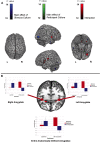Culture, gaze and the neural processing of fear expressions
- PMID: 20019073
- PMCID: PMC2894663
- DOI: 10.1093/scan/nsp047
Culture, gaze and the neural processing of fear expressions
Abstract
The direction of others' eye gaze has important influences on how we perceive their emotional expressions. Here, we examined differences in neural activation to direct- versus averted-gaze fear faces as a function of culture of the participant (Japanese versus US Caucasian), culture of the stimulus face (Japanese versus US Caucasian), and the relation between the two. We employed a previously validated paradigm to examine differences in neural activation in response to rapidly presented direct- versus averted-fear expressions, finding clear evidence for a culturally determined role of gaze in the processing of fear. Greater neural responsivity was apparent to averted- versus direct-gaze fear in several regions related to face and emotion processing, including bilateral amygdalae, when posed on same-culture faces, whereas greater response to direct- versus averted-gaze fear was apparent in these same regions when posed on other-culture faces. We also found preliminary evidence for intercultural variation including differential responses across participants to Japanese versus US Caucasian stimuli, and to a lesser degree differences in how Japanese and US Caucasian participants responded to these stimuli. These findings reveal a meaningful role of culture in the processing of eye gaze and emotion, and highlight their interactive influences in neural processing.
Figures

References
-
- Adams RB, Jr., Franklin RG., Jr Influence of emotional expression on the processing of gaze direction. Motivation & Emotion. 2009;33:106–12.
-
- Adams RB, Jr., Gordon HL, Baird AA, Ambady N, Kleck RE. Effects of gaze on amygdala sensitivity to anger and fear faces. Science. 2003;300:1536. - PubMed
-
- Adams RB, Jr., Kleck RE. Perceived gaze direction and the processing of facial displays of emotion. Psychological Science. 2003;14:644–7. - PubMed
-
- Adams RB, Jr., Kleck RE. Effects of direct and averted gaze on the perception of facially communicated emotion. Emotion. 2005;5:3–11. - PubMed
-
- Adams RB, Jr., Rule N, Franklin RG, Jr., et al. Cross-cultural reading the mind in the eyes. An fMRI investigation. Journal of Cognitive Neuroscience. in press - PubMed

